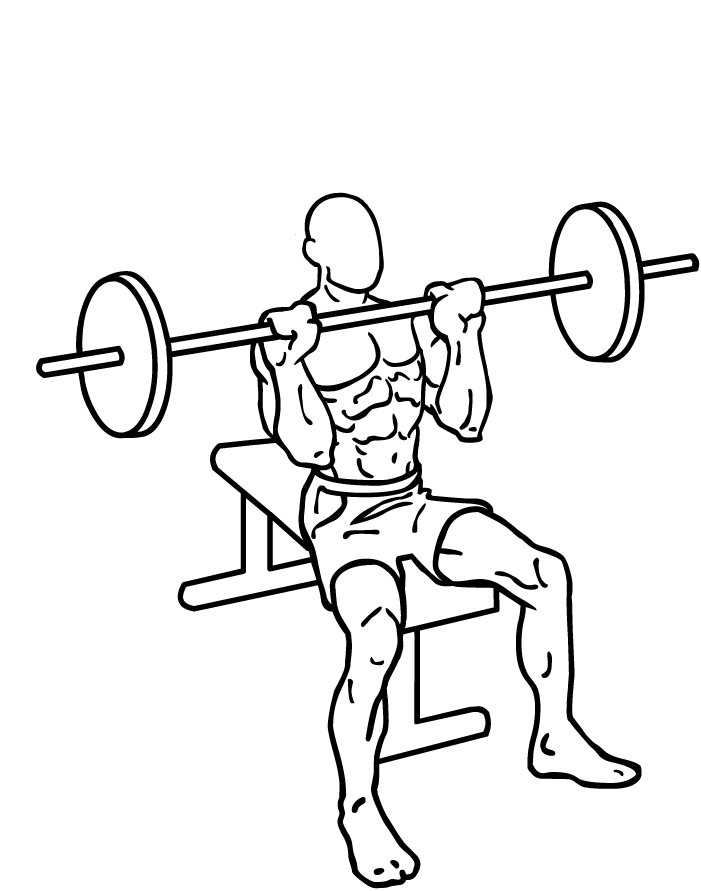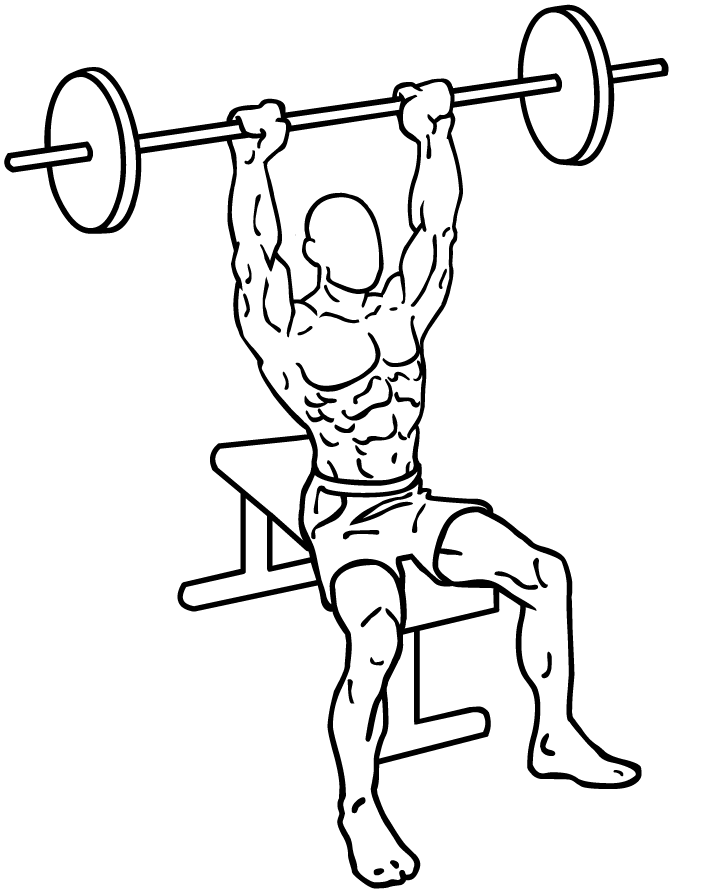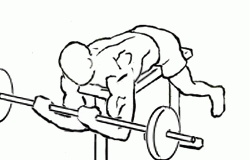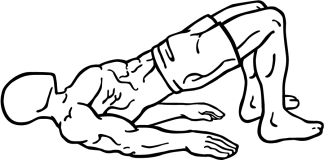Last Updated on September 30, 2022
The Seated Military Press is a classic strength-training exercise that emphasizes the shoulders and triceps, and is a go-to for anyone aiming to build upper body power, improve posture, and enhance shoulder stability. Known for its ability to strengthen the deltoids, this exercise is a staple in many workout routines for its effectiveness in sculpting and fortifying the shoulders.
In this blog, we’ll cover everything you need to know about the Seated Military Press: its benefits, step-by-step execution, tips for proper form, common mistakes, and variations for progressive gains.
Why the Seated Military Press Should Be in Your Routine
The Seated Military Press is highly valued for its focus on the deltoid muscles, which are essential for shoulder strength and stability. Here’s why you should consider adding this exercise to your workouts:
- Shoulder Development: The movement targets the anterior and lateral deltoids, helping to build rounded and strong shoulders.
- Upper Body Strength: It engages the triceps and upper chest, offering comprehensive upper body development.
- Improved Stability: By pressing a weight overhead, you’re challenging your core and back muscles to stabilize your torso, enhancing balance.
- Posture Support: Strengthening the shoulder muscles can improve posture, as it helps prevent rounded shoulders.
Muscles Worked
The Seated Military Press primarily works the following muscles:
- Deltoids: The primary target, focusing on the anterior and lateral heads for well-rounded shoulder development.
- Triceps: Responsible for elbow extension, which is essential for pressing the bar overhead.
- Upper Pectorals: Assist during the lift, especially in the early phase of the press.
- Upper Back and Core Muscles: Stabilize your posture as you perform the movement, preventing your lower back from arching.
Step-by-Step Guide to Performing the Seated Military Press
To execute this exercise safely and effectively, follow these steps:
Equipment Needed:
- Barbell and weight plates
- Adjustable bench with a back support
Steps:
- Set Up Your Bench and Weights: Position a bench under a rack with the barbell at shoulder height. Choose a weight that is challenging but allows you to maintain control throughout the movement.
- Sit with Proper Posture: Sit on the bench with feet flat on the floor, toes pointing straight ahead. Engage your core by drawing in your abs and keep your back straight.
- Grip the Barbell: Grasp the bar with an overhand grip, hands shoulder-width apart. Your palms should face outward.
- Lift the Bar to Starting Position: With the bar in front of your head, keep your elbows slightly forward and your wrists aligned with your elbows.
- Press Upwards: Push the bar overhead by extending your arms, avoiding a full lockout at the top. Focus on moving in a straight line without arching your back.
- Pause and Lower: Pause briefly at the top, then in a controlled movement, lower the bar to just in front of your head, returning to the starting position.
Form and Technique Tips
Good form is essential to maximize the benefits of the Seated Military Press and prevent injury:
- Keep Your Core Tight: Engage your core muscles throughout the movement to maintain stability and prevent lower back strain.
- Avoid Locking Out: At the top, avoid fully locking your elbows. This helps keep tension on your muscles and protects your joints.
- Elbow Positioning: Keep your elbows slightly forward of your shoulders to avoid excess strain on your shoulder joints.
- Proper Foot Position: Keep your feet flat with knees, hips, and ankles at 90 degrees for a solid base.
Common Mistakes to Avoid
While the Seated Military Press is straightforward, it’s important to watch for common mistakes that can compromise form and increase the risk of injury:
- Arching the Lower Back: Leaning too far back strains the lower back. Keep your core engaged to maintain a neutral spine.
- Using Too Much Weight: Heavy weights can lead to poor form and increase the risk of injury. Start with a weight you can control, then progress gradually.
- Incorrect Elbow Position: Allowing the elbows to flare out to the sides can cause shoulder strain. Keep them slightly forward for a safer, more effective press.
- Speeding Through Reps: Rushing through reps reduces muscle activation. Slow, controlled movements are key for proper engagement.
Safety Tips
Safety should always come first in strength training:
- Warm Up: Perform shoulder mobility exercises and light stretching before starting to prepare your muscles.
- Use a Spotter or Safety Rack: If you’re lifting heavy, having a spotter or a safety rack can prevent accidents.
- Avoid if Injured: Skip this exercise if you have existing shoulder or wrist pain, and consult a professional for suitable modifications.
Variations of the Seated Military Press
Adding variations to your routine can help you overcome plateaus and engage different muscles:
1. Dumbbell Shoulder Press
Using dumbbells instead of a barbell allows for a greater range of motion and engages stabilizer muscles more effectively.
Steps:
- Hold a dumbbell in each hand, press them overhead in the same motion as the barbell press, and lower in a controlled manner.
- This can be performed either seated or standing for additional core engagement.
2. Standing Military Press
The standing variation engages the core and lower back, turning it into a more functional full-body movement.
Steps:
- Stand with feet hip-width apart, grip the barbell as in the seated version, and press overhead.
- Keep your core tight and avoid arching your back as you press.
3. Smith Machine Shoulder Press
The Smith machine provides added stability, as the bar moves along a fixed path, which is helpful for beginners or those recovering from injuries.
Steps:
- Position a bench under the Smith machine, set the bar to shoulder height, and perform the press.
4. Behind-the-Neck Shoulder Press (Advanced)
This variation shifts focus slightly to the rear deltoids but can place extra strain on the shoulders. It’s only recommended for those with strong, flexible shoulders.
Steps:
- Instead of pressing the bar in front, lower it behind your head, then press back up.
- Use a lighter weight and ensure proper form.
Incorporating the Seated Military Press into Your Workout Routine
The Seated Military Press fits well in various workout routines. Here’s how to tailor it based on your goals:
- Strength Building: Use heavier weights with lower reps (4–6 reps).
- Muscle Growth (Hypertrophy): Opt for moderate weights with moderate reps (8–12 reps).
- Endurance: Lighter weights and higher reps (15–20 reps) build muscle endurance.
You can pair the Seated Military Press with other shoulder exercises for a well-rounded shoulder workout.
Sample Shoulder Workout Routine
For a balanced shoulder routine, try the following:
- Seated Military Press – 4 sets of 8–10 reps
- Dumbbell Lateral Raises – 3 sets of 12–15 reps
- Front Dumbbell Raises – 3 sets of 10–12 reps
- Rear Delt Flys – 3 sets of 12–15 reps
This workout covers all areas of the shoulder, ensuring balanced development and increased strength.
Progression and Increasing Difficulty
Progressive overload is essential for muscle growth and strength gains. Here are some ways to increase the difficulty:
- Add Weight Gradually: Slowly increase the weight as you gain strength.
- Increase Sets or Reps: Adding extra sets or reps can enhance muscle endurance.
- Slow Down the Tempo: Controlling the tempo, especially during the lowering phase, improves muscle engagement.
Functional Benefits of the Seated Military Press
The Seated Military Press isn’t only beneficial for aesthetics; it also has functional benefits:
- Improved Shoulder Stability: Strong shoulders support better posture and stability.
- Enhanced Sports Performance: Shoulder strength is crucial for many sports, such as swimming, basketball, and tennis.
- Better Daily Functionality: Strong shoulders make everyday tasks, like lifting and carrying, easier.
Seated Military Press vs. Other Shoulder Exercises
Compared to other shoulder exercises, the Seated Military Press has unique benefits:
- Focus on Deltoids: It specifically targets the shoulder muscles, unlike compound exercises that spread the effort across multiple areas.
- Controlled Movement: The seated position stabilizes the core, allowing for more focus on the shoulders.
- Heavier Load Potential: It’s easier to lift heavier in a seated position, leading to greater strength gains.
Frequently Asked Questions
Q: Should I perform the Seated Military Press if I have shoulder pain?
A: If you experience shoulder pain, it’s best to avoid this exercise and consult a professional. Modifications or other exercises may be safer alternatives.
Q: How often should I do the Seated Military Press?
A: Aim to perform this exercise 1–2 times per week to build strength without overloading your shoulders.
Q: What’s the difference between the Seated Military Press and the Seated Shoulder Press?
A: Both exercises are similar, but the Military Press traditionally uses a strict form with a narrower grip, targeting the shoulders and upper chest. The Shoulder Press may allow for more variations in grip width and range of motion.
Q: Should I use a heavy or light weight?
A: It depends on your goals. For strength, opt for a heavier weight with fewer reps. For hypertrophy, use a moderate weight with more reps.
Conclusion
The Seated Military Press is a foundational exercise that can take your shoulder strength and stability to new heights. By following proper form, avoiding common mistakes, and progressively increasing the weight, you’ll see results in both strength and muscle definition. This exercise is versatile and can be adapted for different goals, making it a valuable addition to any workout routine. Whether you’re new to lifting or an experienced athlete, mastering the Seated Military Press will benefit your fitness journey.
Incorporate it into your next shoulder workout, maintain focus on form, and enjoy the powerful benefits of this classic lift!


Exercise images by Everkinetic.






